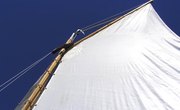
Lexan and Plexiglass are proprietary names for different types of glazing commonly used on recreational boats. Although Lexan is stronger, Plexiglass is in certain respects more durable, Unless the boat is intended for offshore sailing, Plexiglass is the better choice for a boat windshield.
Strength
Lexan is a polycarbonate, which is valued for its strength. This strength, however, is better understood as impact resistance--polycarbonates maintain their integrity by deflecting under impact.
Acrylics, such as Plexiglass, are harder and less flexible than Lexan. They will crack or even shatter under sufficient impact. Nonetheless, they are strong enough for many marine-glazing applications, even in commercially produced hatches intended for blue-water vessels.
Keeping the Water Out
Precisely because Lexan is so flexible, windows made from Lexan are notoriously difficult to keep sealed. Plexiglass windows are less likely to develop leaks.
Scratch Resistance
Because Lexan is relatively soft, it scratches far more quickly that Plexiglass. Even saltwater spray will cause enough damage to eventually obscure a window made from Lexan.
UV Resistance
Lexan is less resistant to ultraviolet (UV) light and degrades more quickly than Plexiglass.
Price
Lexan costs up to 30 percent more than Plexiglass. Moreover, because it deteriorates more quickly than Plexiglass, it will need to be replaced more often.
In Short
In marine glazing applications where strength is critical--such as fitting windows and ports on a blue-water vessel--Lexan may be more appropriate than Plexiglass. In these situations, however, boaters should also consider tempered and laminated glass. For most recreational marine applications, Plexiglass is sufficiently strong, requires less maintenance, lasts longer and is less expensive.
References
Writer Bio
Mick Wolff cruises the South Pacific with his family on a sailboat and has been writing about sailing since 2005. His articles have appeared in "Good Old Boat," "Blue Water Sailing," and "Sail" magazine. He holds a Bachelor of Arts degree from the University of British Columbia and Doctor of Philosophy in history from Cornell University.



